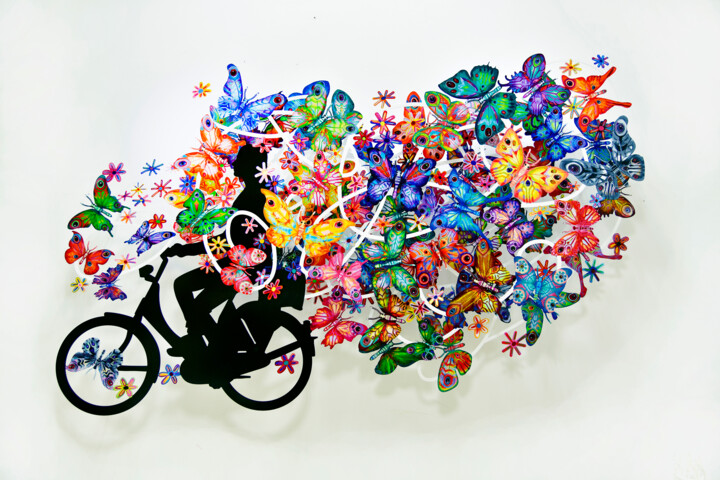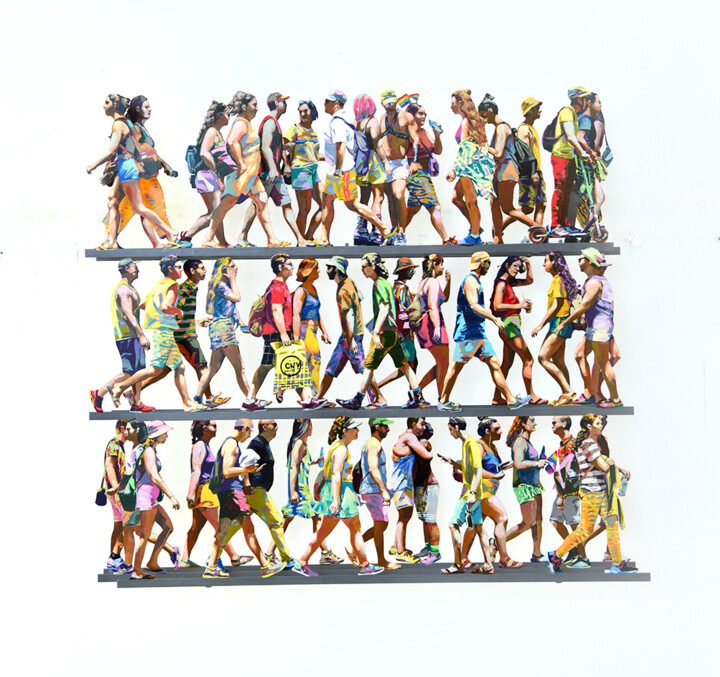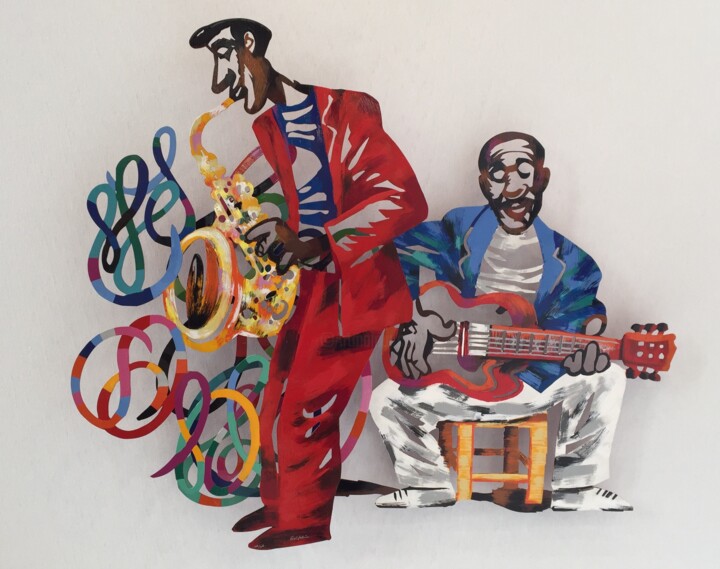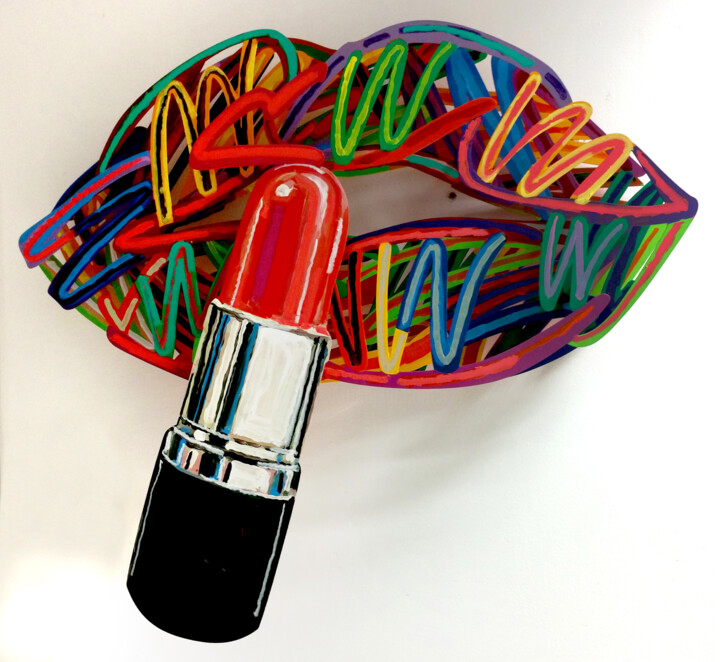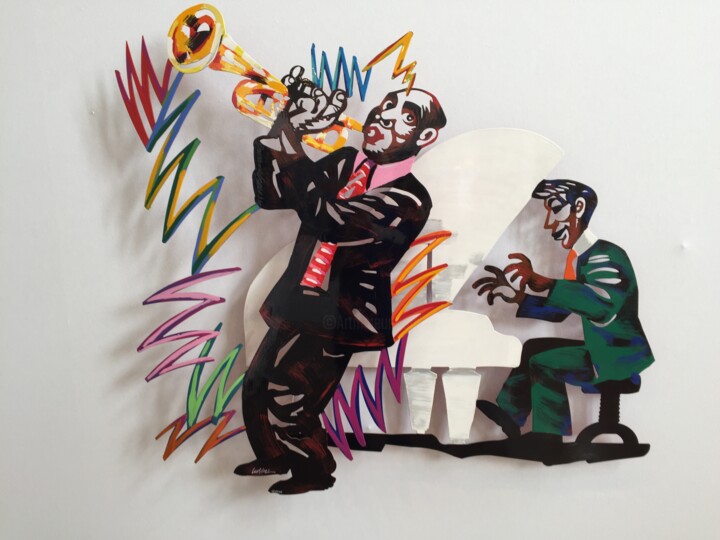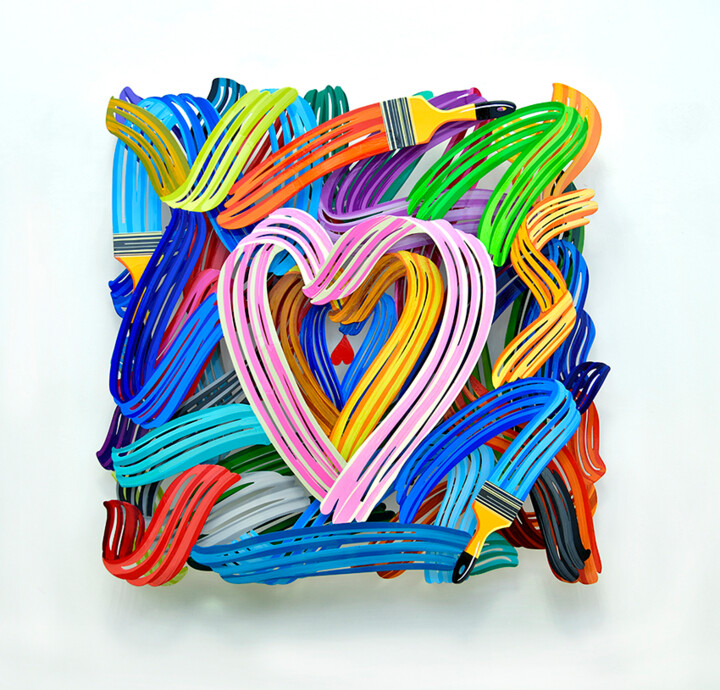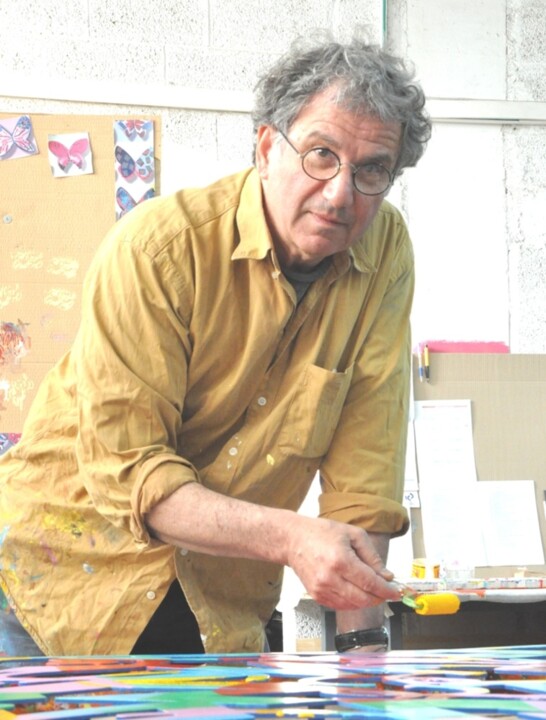
Israeli artist David Gerstein, © David Gerstein via Wikipedia
David (Dudu) Gerstein, born on November 14, 1944, is an Israeli artist known for his evolution from figurative painting to pioneering three-dimensional art forms. Initially recognized for his illustrations, Gerstein transitioned in the late 1970s to creating cutout images and freestanding sculptures that transcended traditional frames. Influenced by pop art icons like Roy Lichtenstein and David Hockney, he developed a vibrant, design-oriented style he termed second-generation pop-art. From 1980 to 1995, he focused on wooden sculptures before adopting laser-cutting technology to create multi-layered steel wall-sculptures, becoming the first artist to do so. Gerstein's work includes over 40 public space sculptures in Israel and numerous large-scale pieces worldwide. His art has been exhibited globally, with significant installations such as "Momentum" in Singapore and sculptures admired by figures like Lance Armstrong and Stephen King. In 2016, he received Taiwan's Artistic Creation Award.
Artist Biography: David Gerstein
David (Dudu) Gerstein, born in 1944 in Jerusalem to Polish immigrant parents, demonstrated early artistic promise alongside his twin brother Jonathan (Yoni). Their upbringing fostered a deep appreciation for art, with young David profoundly moved by the impressionists and other historical art movements encountered at local galleries. His artistic journey formally began with studies at Beit Zvi Art Center in Ramat Gan and later, at age 11, a pivotal encounter with Picasso's "Guernica" sparked his interest in modern art, particularly cubism and expressionism. Following mandatory military service where he painted landscapes and scenes of daily life, Gerstein pursued formal art education at Bezalel Academy of Arts and Design in Jerusalem, influenced significantly by teacher Avraham Ofek.
In 1966, driven by a dream to visit Paris, Gerstein enrolled at the École nationale supérieure des Beaux-Arts, studying under Chapelain-Midy during a transformative period that included the 1968 revolution. Subsequently, he moved to New York, refining his skills at the Art Students League under notable mentors. Returning to Israel, Gerstein joined Bezalel Academy as a faculty member, initially teaching drawing before shaping the Department of Jewelry Design to integrate contemporary art movements and concepts. Gerstein's artistic evolution saw him pursue printmaking at Saint Martin's School of Art in London, earning his Masters of Art and pioneering integrative techniques in lithography and silkscreen printing. This period marked his transition from painting to sculpture, influenced by his innovative approach to combining mediums. Throughout the 1970s and 1980s, Gerstein's work evolved from oil paintings to wood sculptures, culminating in a residency in Paris where he revisited themes of balconies and automotive motifs, exploring new perspectives and narrative depths.
In the mid-1990s, Gerstein's artistic trajectory was profoundly altered by the discovery of laser cutting technology, which revolutionized his approach to sculpture. His multi-layered, laser-cut metal artworks, hand-painted in vivid automotive gloss, became iconic for their three-dimensional quality and vibrant palette. These sculptures, often depicting dynamic scenes and everyday moments, expanded Gerstein's international acclaim and solidified his reputation as a master of contemporary sculpture.
Throughout his career, Gerstein exhibited extensively worldwide, with notable solo shows at prestigious venues including the Israel Museum, Haifa Museum of Contemporary Art, and galleries in major cities across Europe, Asia, and the Americas. His work, characterized by its joyful exuberance and exploration of urban life, continues to resonate with audiences globally, bridging the gap between fine art and public engagement.
Artistry of David Gerstein
David Gerstein's artistic journey is marked by a profound exploration of personal themes and a continuous quest to integrate painting with three-dimensional sculpture. In the 1970s, Gerstein gained recognition for his figurative paintings that drew inspiration from his childhood memories and Israeli daily life. His early works in watercolors and gouache on paper depicted scenes from his upbringing, including intimate family moments and nostalgic portrayals of Tel Aviv balconies, which became recurring motifs throughout his career. Gerstein's paintings of this period often featured subjects like bicycles ridden by his mother and serene interior settings adorned with symbolic elements such as cats and flower vases, reflecting his fascination with the contrast between private and public spheres.
Transitioning to sculpture in the 1980s, Gerstein experimented with wood and later aluminum to create dynamic, three-dimensional artworks that retained a distinctive two-dimensional quality. His sculptures, initially shown at galleries like Horace Richter and later at international exhibitions, introduced playful elements reminiscent of toys and paper cutouts, earning him acclaim for their colorful and whimsical appeal. Notably, his "Art Cats" series, commissioned by New York art dealer Marilyn Goldberg, showcased his ability to blend humor with artistic homage, incorporating influences from renowned artists such as van Gogh and Picasso.
Gerstein's artistic evolution continued into the 1990s with the adoption of laser-cutting technology, which revolutionized his approach to sculpture. This innovation allowed him to create multi-layered, vibrant metal sculptures that defied traditional boundaries, earning him accolades for their technical sophistication and visual impact. His sculptures, characterized by bold primary colors and intricate designs, expanded beyond gallery spaces to public settings worldwide. From Israel to Taiwan, Korea, and China, Gerstein's large-scale outdoor sculptures, including the towering artwork in Singapore's business district, became landmarks celebrated for their monumental presence and accessibility to the public.
Central to Gerstein's artistic philosophy is the intersection of art and everyday life, conveyed through his use of vivid colors and thematic motifs that engage viewers on multiple levels. His work critiques consumerism while celebrating the aesthetic allure of vibrant hues, inviting observers to appreciate both the surface beauty and underlying narratives within his art. Gerstein's belief in breaking down barriers between art and its audience underscores his commitment to creating artworks that resonate beyond traditional gallery spaces, embodying a philosophy that art should be both visually striking and intellectually stimulating.
Drop of Love (2021) by David Gerstein
David Gerstein, Drop of Love, 2021. Number of copies : 150. Sculpture, Aluminium on Aluminium, 115cm, x 115cm.
David Gerstein's Drop of Love, created in 2021, stands as a testament to his mastery of sculptural form and vibrant use of color. Measuring 115 x 115 x 15 cm, this edition is limited to 150 copies, each meticulously crafted from laser-cut aluminium and hand-painted to accentuate its dynamic design. The sculpture exemplifies Gerstein's signature style, characterized by its intricate layers and playful exploration of space and dimensionality. Drop of Love captures the essence of fluidity and movement through its abstract depiction, inviting viewers to contemplate themes of affection and connectivity through the artist's distinctive visual language. This piece not only showcases Gerstein's technical prowess in aluminium sculpture but also underscores his ability to imbue his artworks with emotional depth and universal appeal.
Blue Note B (1999) by David Gerstein
David Gerstein, Blue Note B, 1999. Sculpture, Metals on Metal, 99cm x 110cm / 11.00 kg.
Blue Note B, a limited edition sculpture by David Gerstein created in 1999, stands as a vibrant homage to the spirit of jazz music. This meticulously crafted piece, numbered 148 out of 300, portrays a saxophonist and guitarist in dynamic motion, capturing the essence and energy of their performance. Standing at 99 cm in height and 110 cm in width, and weighing 11.00 kg, the sculpture uses metals to evoke a sense of malleability and light reflection, enhancing its visual appeal. Gerstein's artistic mastery is evident in the sculpture's figurative style, where abstract shapes and dynamic lines converge to create a vivid composition. The saxophonist is depicted in a moment of intense musical expression, while the guitarist complements with equal fervor, embodying the rhythmic and improvisational nature of jazz. Vibrant colors and subtle details bring the artwork to life, reflecting the evocative atmosphere and creative spirit intrinsic to this genre of music. Blue Note B not only celebrates the technical virtuosity of its subjects but also pays homage to the broader cultural significance of jazz. Through Gerstein's sculptural technique, which includes welding and assembly, he not only captures the physicality of the musicians but also imbues the sculpture with a sense of movement and spontaneity, echoing the dynamic nature of live jazz performances. This artwork serves as a testament to Gerstein's ability to blend artistry with narrative, inviting viewers to experience the rhythm and soul of jazz through his unique visual language.
In recent years, David Gerstein has faced criticism regarding his artistic approach, particularly concerning his use of vibrant colors and creation of serial sculptures which some deem as commercial rather than purely artistic endeavors. Gerstein defends his colorful palette, asserting that the forms and hues in his work serve as a means of communication that goes beyond mere decoration, offering viewers a deeper, metaphorical insight into the human condition. He argues that while his sculptures may appear decorative on the surface, they carry a substantive critique of existence itself, exploring themes of life's cyclical nature and existential pursuit. Addressing critiques about his serial production, Gerstein draws a comparison to Andy Warhol's silkscreens, emphasizing that art should be accessible to all, regardless of how it is produced or marketed. He advocates for art's universal appeal and believes that everyone should have the opportunity to appreciate and engage with artistic expression, whether through individual works or serial productions.
Exhibition History
David Gerstein's prolific exhibition history spans across the globe, showcasing his dynamic career as both a painter and sculptor. His early exhibitions in Israel, starting with the Engel Gallery in Jerusalem in 1971 and followed by The Artists' House in 1972, marked the beginnings of his exploration into figurative art amidst an Israeli art scene dominated by conceptualism. Throughout the 1980s and 1990s, Gerstein's exhibitions at renowned venues like the Horace Richter Gallery in Tel Aviv and international platforms such as the Albert White Gallery in Toronto and the Art Frankfurt International Art Fair solidified his reputation for vibrant, narrative-driven paintings and sculptures. Notable highlights include solo shows at prestigious institutions like the Israel Museum in Jerusalem and the Haifa Museum of Contemporary Art, where themes of everyday life and human interaction resonated deeply. Gerstein's global footprint expanded further with exhibitions in diverse locales such as New York, Seoul, Paris, Beijing, and beyond, consistently showcasing his evolving artistic vision and mastery of form. His exhibitions in recent years continue to reflect his enduring commitment to exploring the complexities of human experience through art, cementing his status as a leading figure in contemporary visual arts.
David Gerstein's enduring legacy lies in his ability to blend artistic innovation with a deep appreciation for everyday experiences and human emotions. His sculptures and paintings continue to resonate globally, celebrated for their technical brilliance and whimsical charm. Gerstein's commitment to pushing the boundaries of art through experimentation with materials and techniques remains a cornerstone of his creative ethos, inspiring generations of artists and art enthusiasts alike.
David Gerstein's expansive career is a testament to his enduring impact on contemporary art, characterized by a dynamic evolution from figurative painting to pioneering three-dimensional sculptures. Born in 1944 in Jerusalem, Gerstein initially gained recognition for his illustrations before transitioning to cutout images and freestanding sculptures in the late 1970s. Inspired by pop art luminaries like Roy Lichtenstein and David Hockney, he developed a distinctive style blending vibrant colors with industrial materials, notably steel and aluminum. Throughout his career, Gerstein's work has been celebrated for its accessibility and universal appeal, evident in over 40 public sculptures worldwide and exhibitions at prestigious venues from Tel Aviv to New York, Seoul to Paris. His art, characterized by playful motifs and bold compositions, invites viewers to engage with themes of urban life, nature, and the human experience, underscoring Gerstein's profound impact on contemporary art discourse and public art installations globally.




 Selena Mattei
Selena Mattei

